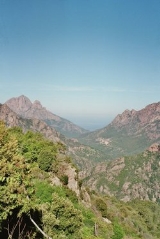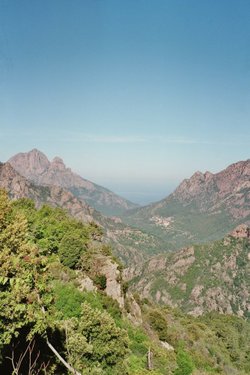
Mateo Falcone
Encyclopedia
Mateo Falcone is a one-act opera
composed by César Cui
during 1906-1907. (Actually, Cui designated the genre of this work as "dramatic scene.") The libretto
was adapted by the composer
from Prosper Merimée
's like-named story from 1829 and Vasily Zhukovsky
's verse
rendering thereof. It was premiered on 14 December 1907 (Old Style
), at the Bolshoi Theatre
in Moscow
(the work was given along with the composer's early one-act comic opera, The Mandarin's Son
). The premiere production of Mateo was a failure; the work never became part of the standard operatic repertoire in Russia
, and seems never to have been performed again.
.
The musical setting of the text of Mateo Falcone has a declamatory-melodic character, in keeping with the composer's veneration, if not slavish emulation, of Alexander Dargomyzhsky
's method of "melodic recitative," which had been most thoroughly demonstrated in The Stone Guest
. There are no extractable "numbers" from this opera to speak of, although highlights include the orchestral passages that suggest the rustic scenery with a kind of barcarolle
, and the intimate Latin
prayer
near the end (a setting of "Ave Maria
"), which is reminiscent of the composer's art song
s.
Setting: Corsica
, 1800s

while his parents are away. Shots ring out in the distance, and Sanpiero runs in, wounded. Fleeing the police, he asks Fortunato to hide him. Fortunato asks for and gets some money in return, and hides Sanpiero, the smuggler.
The police arrive, led by Gamba, who is a distant cousin of Mateo. They search the house and try to get information out of Fortunato, who resists with juvenile evasions until Gamba tempts the boy with an enamel
-encased watch. Fortunato takes the bribe and reveals Sanpiero.
Mateo and his wife return. After Gamba tells them of their son's help in capturing Sanpiero, the wounded man curses the Falcone household for betrayal as he is carried away. Mateo has only one thing to do to preserve the honor of his family: he takes his son away from the house, says prayers with him, and kills him with a single gunshot.
Opera
Opera is an art form in which singers and musicians perform a dramatic work combining text and musical score, usually in a theatrical setting. Opera incorporates many of the elements of spoken theatre, such as acting, scenery, and costumes and sometimes includes dance...
composed by César Cui
César Cui
César Antonovich Cui was a Russian of French and Lithuanian descent. His profession was as an army officer and a teacher of fortifications; his avocational life has particular significance in the history of music, in that he was a composer and music critic; in this sideline he is known as a...
during 1906-1907. (Actually, Cui designated the genre of this work as "dramatic scene.") The libretto
Libretto
A libretto is the text used in an extended musical work such as an opera, operetta, masque, oratorio, cantata, or musical. The term "libretto" is also sometimes used to refer to the text of major liturgical works, such as mass, requiem, and sacred cantata, or even the story line of a...
was adapted by the composer
Composer
A composer is a person who creates music, either by musical notation or oral tradition, for interpretation and performance, or through direct manipulation of sonic material through electronic media...
from Prosper Merimée
Prosper Mérimée
Prosper Mérimée was a French dramatist, historian, archaeologist, and short story writer. He is perhaps best known for his novella Carmen, which became the basis of Bizet's opera Carmen.-Life:...
's like-named story from 1829 and Vasily Zhukovsky
Vasily Zhukovsky
Vasily Andreyevich Zhukovsky was the foremost Russian poet of the 1810s and a leading figure in Russian literature in the first half of the 19th century...
's verse
Poetry
Poetry is a form of literary art in which language is used for its aesthetic and evocative qualities in addition to, or in lieu of, its apparent meaning...
rendering thereof. It was premiered on 14 December 1907 (Old Style
Old Style and New Style dates
Old Style and New Style are used in English language historical studies either to indicate that the start of the Julian year has been adjusted to start on 1 January even though documents written at the time use a different start of year ; or to indicate that a date conforms to the Julian...
), at the Bolshoi Theatre
Bolshoi Theatre
The Bolshoi Theatre is a historic theatre in Moscow, Russia, designed by architect Joseph Bové, which holds performances of ballet and opera. The Bolshoi Ballet and Bolshoi Opera are amongst the oldest and most renowned ballet and opera companies in the world...
in Moscow
Moscow
Moscow is the capital, the most populous city, and the most populous federal subject of Russia. The city is a major political, economic, cultural, scientific, religious, financial, educational, and transportation centre of Russia and the continent...
(the work was given along with the composer's early one-act comic opera, The Mandarin's Son
The Mandarin's Son
The Mandarin's Son is comic opera in one act by César Cui, composed in 1859. The libretto, which includes spoken dialogue, was written by V.A...
). The premiere production of Mateo was a failure; the work never became part of the standard operatic repertoire in Russia
Russia
Russia or , officially known as both Russia and the Russian Federation , is a country in northern Eurasia. It is a federal semi-presidential republic, comprising 83 federal subjects...
, and seems never to have been performed again.
Background
This opera constitutes the last of three short serious operas by this composer, the other two being Feast in Time of Plague and Mademoiselle FifiMademoiselle Fifi (Cui)
Mademoiselle Fifi is an opera in one act, composed by César Cui during 1902-1903...
.
The musical setting of the text of Mateo Falcone has a declamatory-melodic character, in keeping with the composer's veneration, if not slavish emulation, of Alexander Dargomyzhsky
Alexander Dargomyzhsky
Alexander Sergeyevich Dargomyzhsky was a 19th century Russian composer. He bridged the gap in Russian opera composition between Mikhail Glinka and the later generation of The Five and Tchaikovsky....
's method of "melodic recitative," which had been most thoroughly demonstrated in The Stone Guest
The Stone Guest (Dargomyzhsky)
The Stone Guest is an opera in three acts by Alexander Dargomyzhsky. The libretto was taken almost verbatim from Alexander Pushkin's like-named play in blank verse , with slight changes in wording and the interpolation of two songs indicated in the play...
. There are no extractable "numbers" from this opera to speak of, although highlights include the orchestral passages that suggest the rustic scenery with a kind of barcarolle
Barcarolle
A barcarole is a folk song sung by Venetian gondoliers, or a piece of music composed in that style...
, and the intimate Latin
Latin
Latin is an Italic language originally spoken in Latium and Ancient Rome. It, along with most European languages, is a descendant of the ancient Proto-Indo-European language. Although it is considered a dead language, a number of scholars and members of the Christian clergy speak it fluently, and...
prayer
Prayer
Prayer is a form of religious practice that seeks to activate a volitional rapport to a deity through deliberate practice. Prayer may be either individual or communal and take place in public or in private. It may involve the use of words or song. When language is used, prayer may take the form of...
near the end (a setting of "Ave Maria
Hail Mary
The Angelic Salutation, Hail Mary, or Ave Maria is a traditional biblical Catholic prayer asking for the intercession of the Virgin Mary, the mother of Jesus. The Hail Mary is used within the Catholic Church, and it forms the basis of the Rosary...
"), which is reminiscent of the composer's art song
Art song
An art song is a vocal music composition, usually written for one voice with piano or orchestral accompaniment. By extension, the term "art song" is used to refer to the genre of such songs....
s.
Characters and Setting
- Mateo Falcone: baritoneBaritoneBaritone is a type of male singing voice that lies between the bass and tenor voices. It is the most common male voice. Originally from the Greek , meaning deep sounding, music for this voice is typically written in the range from the second F below middle C to the F above middle C Baritone (or...
- Giuseppa, his wife: sopranoSopranoA soprano is a voice type with a vocal range from approximately middle C to "high A" in choral music, or to "soprano C" or higher in operatic music. In four-part chorale style harmony, the soprano takes the highest part, which usually encompasses the melody...
- Fortunato, their son: altoAltoAlto is a musical term, derived from the Latin word altus, meaning "high" in Italian, that has several possible interpretations.When designating instruments, "alto" frequently refers to a member of an instrumental family that has the second highest range, below that of the treble or soprano. Hence,...
- Sanpiero, a smuggler: tenorTenorThe tenor is a type of male singing voice and is the highest male voice within the modal register. The typical tenor voice lies between C3, the C one octave below middle C, to the A above middle C in choral music, and up to high C in solo work. The low extreme for tenors is roughly B2...
- Gamba, a sergeantSergeantSergeant is a rank used in some form by most militaries, police forces, and other uniformed organizations around the world. Its origins are the Latin serviens, "one who serves", through the French term Sergent....
: bass - A few soldiers [i.e., gendarmesGendarmerieA gendarmerie or gendarmery is a military force charged with police duties among civilian populations. Members of such a force are typically called "gendarmes". The Shorter Oxford English Dictionary describes a gendarme as "a soldier who is employed on police duties" and a "gendarmery, -erie" as...
]: tenors and basses
Setting: Corsica
Corsica
Corsica is an island in the Mediterranean Sea. It is located west of Italy, southeast of the French mainland, and north of the island of Sardinia....
, 1800s

Synopsis
The boy Fortunato is outside of his family's house, playing a hornHorn (instrument)
The horn is a brass instrument consisting of about of tubing wrapped into a coil with a flared bell. A musician who plays the horn is called a horn player ....
while his parents are away. Shots ring out in the distance, and Sanpiero runs in, wounded. Fleeing the police, he asks Fortunato to hide him. Fortunato asks for and gets some money in return, and hides Sanpiero, the smuggler.
The police arrive, led by Gamba, who is a distant cousin of Mateo. They search the house and try to get information out of Fortunato, who resists with juvenile evasions until Gamba tempts the boy with an enamel
Vitreous enamel
Vitreous enamel, also porcelain enamel in U.S. English, is a material made by fusing powdered glass to a substrate by firing, usually between 750 and 850 °C...
-encased watch. Fortunato takes the bribe and reveals Sanpiero.
Mateo and his wife return. After Gamba tells them of their son's help in capturing Sanpiero, the wounded man curses the Falcone household for betrayal as he is carried away. Mateo has only one thing to do to preserve the honor of his family: he takes his son away from the house, says prayers with him, and kills him with a single gunshot.

